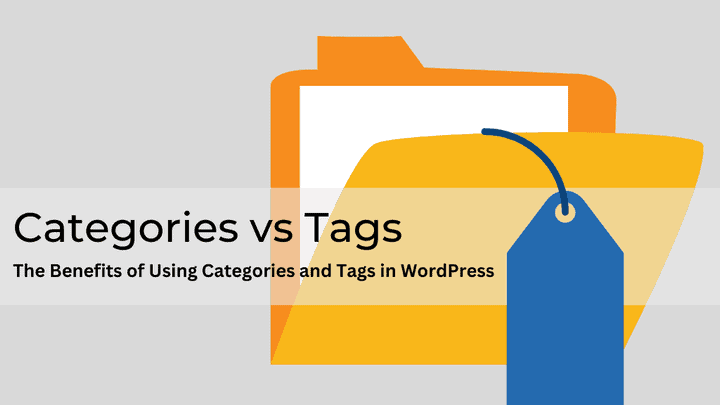You know the organization is key if you’re running a WordPress site. After all, a well-organized site is easier to navigate and looks more professional. Fortunately, WordPress makes it easy to keep your site organized using categories and tags. In this blog post, we’ll discuss the benefits of using both.

Categories vs. Tags
Before we get into the benefits of using categories vs tags, let’s take a quick moment to review the difference between the two. Categories are meant to be broad, high-level labels for your content. For example, if you have a blog about fitness, some of your categories might be “Exercise,” “Nutrition,” and “Wellness.” Meanwhile, tags are meant to be more specific labels for your content. Using the fitness blog example, some tags might be “weight loss,” “heart health,” and “strength training.”
The Benefits of Using Categories in WordPress
As mentioned above, categories are meant to be broad, high-level labels. That means they’re great for giving your readers an overview of the topics you write about. Categories also make it easy for new readers to find content that interests them on your site. For example, say someone stumbles across your fitness blog while they’re looking for tips on how to start working out. If they see that you have a category devoted to exercise, they will likely click through and check out some of your posts.
In addition to helping readers find the content they’re interested in, categories can also help improve your SEO. That’s because each category page acts as its mini website, complete with its title tag and meta description. As a result, whenever you add a new post to a particular category, you effectively give yourself another opportunity to rank in Google search results.
The Benefits of Using Tags in WordPress
Tags are more specific than categories, making them ideal for helping readers find exactly what they’re looking for on your site. For example, let’s say someone is reading one of your posts about starting a workout routine and wants more information on choosing the right gym membership. If you’ve tagged all of your gym-related posts with “gym memberships,” then it will be easy for them to find the information they need—and they’ll appreciate not having to dig through all of your other content to find it.
Tags can quickly become unruly, so it’s important to use them sparingly and only when they genuinely add value to your readers. A good rule of thumb is to use no more than three or four tags per post. Any more than that, and you run the risk of overwhelming your readers (not to mention polluting your website with excessive pages).
When used correctly, tags can also help improve your SEO, much like categories. That’s because each tag page acts as its mini website, complete with its title tag and meta description (sound familiar?). So every time you add a new post with a particular tag, you’re giving yourself another opportunity to rank in Google search results—which can help attract new readers and potential customers to your site over time.
How to create categories and tags in WordPress
Now that we’ve discussed the benefits of using categories and tags in WordPress, let’s discuss how to create them.
Creating Categories in WordPress
To create a new category in WordPress, click on the “Posts” link in the left-hand sidebar and select “Categories” from the dropdown menu on the right-hand sidebar.
On the next page, you’ll see a list of all the existing categories on your site (if any). To add a new category, enter its name in the “Add New Category” field and click on the “Add New Category” button.
Creating Tags in WordPress
Creating tags in WordPress is just as easy as creating categories. To get started, click on the “Posts” link in the left-hand sidebar and select “Tags” from the dropdown menu on the right-hand sidebar.
On the next page, you’ll see a list of all the existing tags on your site (if any). To add a new tag, enter its name in the “Add New Tag” field and then click on the “Add” button.”
Conclusion
As you can see, both categories and tags can help organize your WordPress site—but they each serve a different purpose. Categories are great for giving readers an overview of the topics you write about, while tags are better suited for helping them find specific posts they’re interested in reading. In addition, both can help improve your SEO if used correctly. So next time you’re adding new content to your WordPress site, take a moment to consider which categories or tags it belongs in—it just might make it easier for someone (like a new reader or customer!) to find it down the road.”

